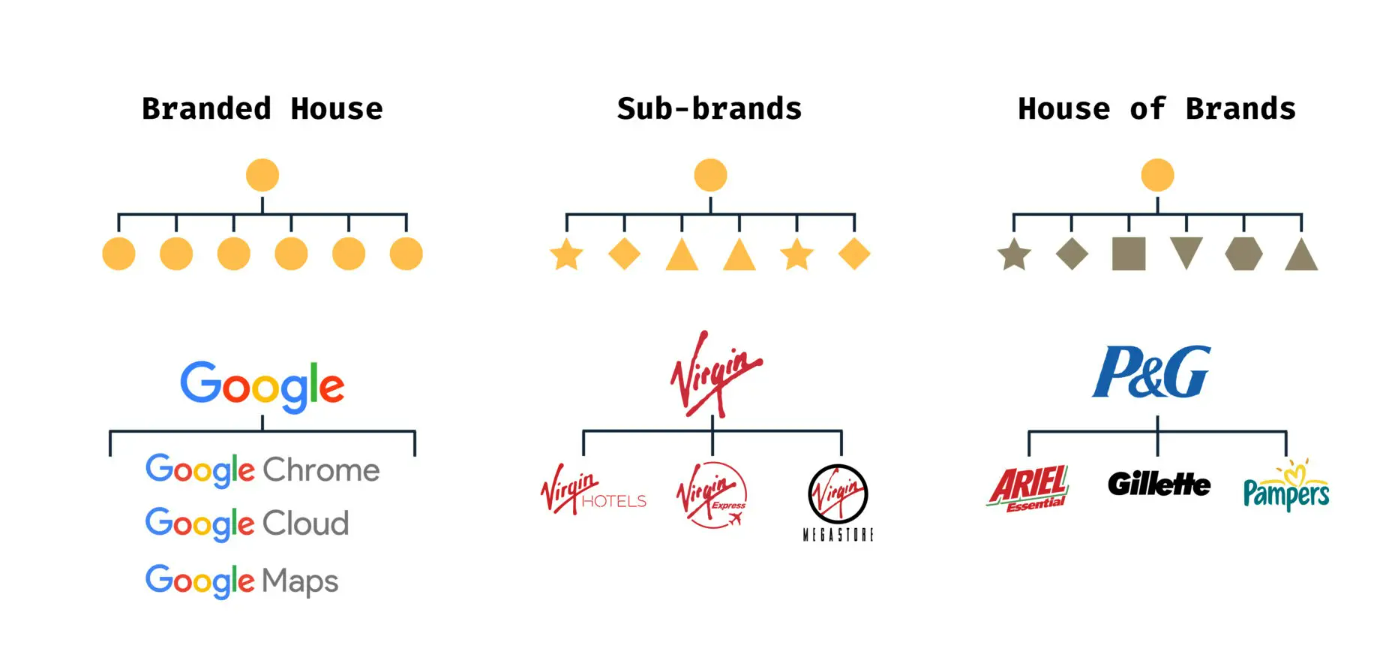Brand architecture is an important aspect of marketing and business strategy that should not be taken lightly. It involves deciding on the relation between the corporate brand and all the brands, sub-brands, products, variants, and acquired businesses in the company’s portfolio. Let’s explore the main three architecture types, with a focus on two primary types of brand architecture – ‘branded house’ and ‘house of brands’ – and their implications for marketing and communication strategies. Knowing these brand architecture can help you find the right one that suits your product portfolio.

Branded House
A branded house company uses one Masterbrand to represent all its products and offerings. The products don’t have separate identities, and all contribute to the strength of the Masterbrand. Examples of branded house companies include HSBC, Virgin, and Amazon.

Coca-Cola can be cited as an example for such a brand that has changed its brand architecture, moving closer to a branded house. The ‘One Brand’ strategy resulted in Diet Coke, Coca-Cola Zero Sugar, and Coca-Cola Life being advertised under the main Coca-Cola umbrella. This turned the three sub-brands into variants of the main brand.
Another example of a company that understands the importance of strengthening its Masterbrand is Microsoft. Despite having many strong product brands such as Windows and Office, as well as independent brands like Skype, Xbox, and LinkedIn, Microsoft wants to move them closer to the overarching Microsoft umbrella. The company executives often express concerns that people don’t know these brands are part of Microsoft, which is an issue they need to solve. Microsoft probably will never become a branded house, but it’s clear it wants to move towards this in the future.
A branded house architecture is suitable when a company targets a similar audience with different products and wants to build the same proposition and associations for different offerings. It’s also appropriate when an organization has a limited marketing budget, as it’s cheaper to build awareness of just one brand. Finally, it should be used when reputation risk related to different products is low, as one wrong move could affect the whole company.
House of Brands
In contrast, a house of brands has many varied products and offerings marketed under separate brands, each with its own identity. Examples of house of brands companies include Procter & Gamble and Unilever.

While branded house companies try to make their new products or acquisitions part of the Masterbrand in their marketing and communication, there’s a clear separation between parent companies and their brands in a house of brands structure. Brands like P&G and Unilever now accentuate their corporate brands when promoting consumer brands, in a way stepping back from this strategy.
A house of brands structure is recommended when an organization targets different audiences with the same product categories and wants to build different propositions and new associations for different products. It’s convenient when reputation risk related to different products is high, and you don’t want other brands in your portfolio to be affected. However, it’s crucial to remember that this brand architecture can be effectively applied only if there’s a substantial marketing budget to build awareness of each individual brand.
Hybrid Model
This architecture combines Branded House and House of Brands strategies. Sub-brands receive some parent brand support but remain autonomous. For example, Courtyard by Marriott leverages Marriott’s name but establishes an independent identity.

Also Toyota has a Hybrid Architecture, with brands like Lexus for luxury and Daihatsu for economy. They offer SUVs and sedans, catering to diverse clients. This model provides flexible brand positioning. But it can confuse customers and is expensive to manage separate brands.
Choosing Your Brand Architecture
Changing a brand architecture is not just a creative exercise involving a new naming approach. A thoughtful brand architecture strengthens your brand assets and sets your organization up for success. The following pointers may help you find the best one most suited for you:
- Consider your business strategy and brand portfolio complexity.
- Assess brand extension opportunities and risks.
- A simple Branded House model may suit a straightforward brand, while a House of Brands allows maximum differentiation.
- Regardless of structure, ensure customers perceive sub-brands as intended.
- Review your architecture periodically to keep it aligned with business goals as offerings evolve.
The Takeaway
Brand architecture is an essential business decision that can impact how a company communicates and markets its products. The two primary types of brand architecture are branded house and house of brands. Branded house is suitable for companies targeting a similar audience with different products, while a house of brands structure is recommended when an organization targets different audiences with the same product categories. Changing brand architecture is a substantial task that requires professional help and an in-depth understanding of your business and market.
Also Read: Effective Branding Strategies to Captivate Your Audience This Summer



